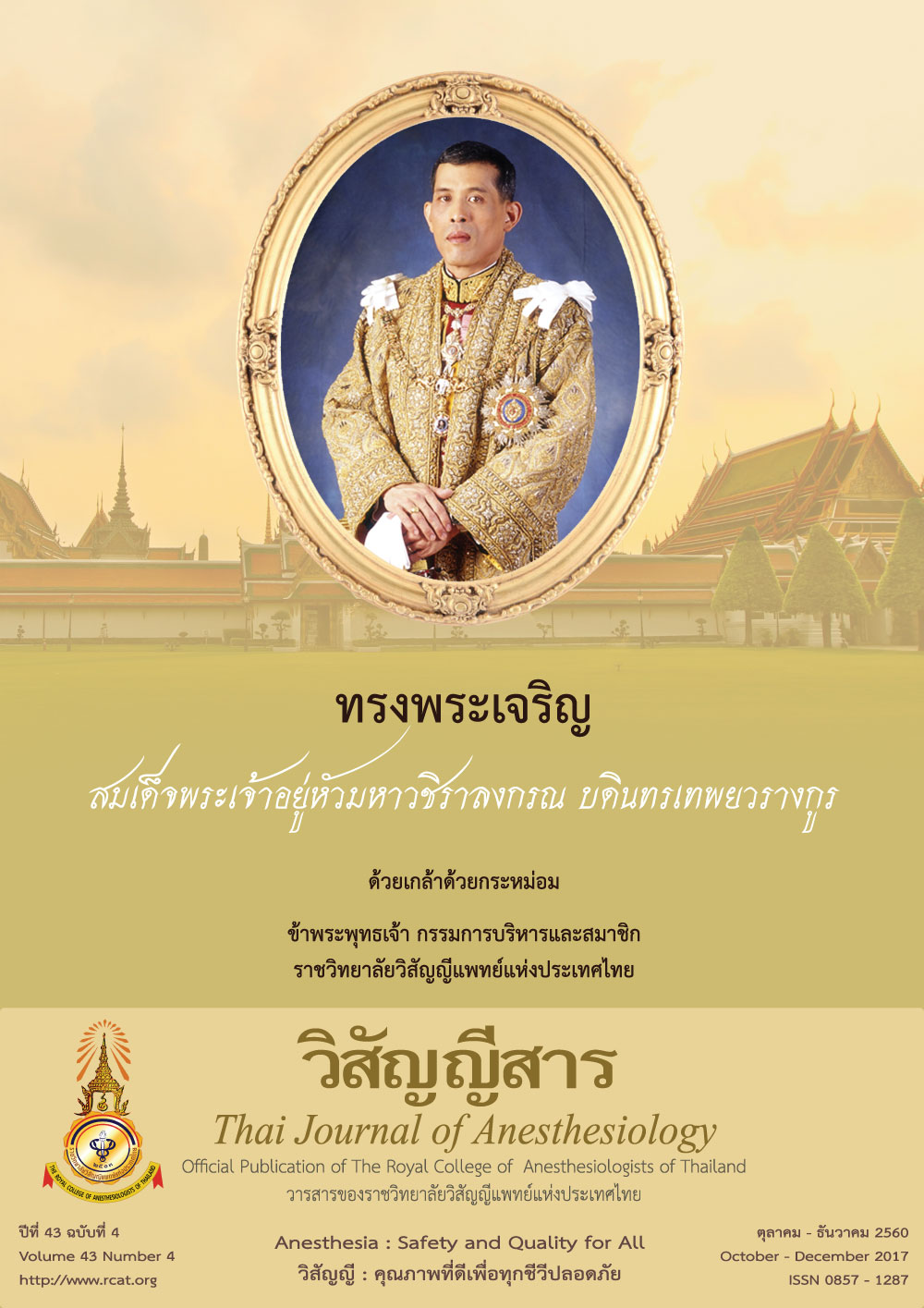Proportion and usage of cuffed endotracheal tube in children undergoing surgery under general anesthesia in Maharaj Nakorn Chiang Mai Hospital
Main Article Content
Abstract
Background: Cuffed endotracheal tubes [COT]
become more frequently used instead of non-cuffed
endotracheal tube [NCOT] for sufficient ventilation
in pediatric patients during general anesthesia. Age
based formulas have been widely used to predicted
the appropriate size and depth of cuffed endotracheal
tube however these formula are based on western
population. The goal of study was to determine
proportion of cuffed endotracheal tube used in
children and whether the selection of COT using age
based formulas was appropriate for Thai children
in terms of depth and size. Methods: After the
approval of The Institutional Ethics Committee, the
retrospective descriptive study was conducted in
children aged 2–8 years that were intubated with
COT in Maharaj Nakorn Chiang Mai Hospital
between January 1, 2012 - December 31, 2012. The
exclusion criteria were airway abnormality. In our
institute, pediatric COT size is selected by using the
age based formula for size {Internal diameter [mm.]
= 3.5 + age/4} and depth {depth [cm.] = 12 + age/2}.
Age, gender, weight, type of endotracheal tube,
tube size, tube depth and type of operation were
record. Percentage was performed for all variables.
The primary outcome was proportional COT usage.
The secondary outcome was to compare the calculated
tube size and depth to the actual size and depth of COT
that was used in each of the patient. Results: Three
hundred and ten records were analyzed. The proportion
of COT used was 39% (122/310) as a primary outcome
then one hundred and twenty two patients who were
intubated with COT were analyzed for secondary
outcome. The calculated size and depth of COT were
smaller and shallower than actually usage in all age
group. Conclusions: At present we often use COT in
pediatric patients. Tube size and depth that calculated
from age based formulas are smaller and shallower than
practical use. Further prospective study is warranted.
Article Details
References
effect of cuffed endotracheal tube on respiratory
complication following adenotonsillectomy in children.
MJIRI.2010;24:151-8.
2. Murat I. Cuffed tubes in children: a 3-year experience in a
single institution. Paediatr Anaesth. 2001;11(6):748–9.
3. Weiss M, Dullenkopt A, Fischer JE, Keller C, Gerber AC.
Prospective randomized controlled multi-centre trial of
cuffed or uncuffed endotracheal tubes in small children.
Br J Anaesth. 2009;103(6):867-73.
4. Fine GF, Borland LM. The future of the cuffed endotracheal
tube. Paediatr Anaesth. 2004;14(1):38-42.
5. Newth CJ, Rachmann B, Patel N, Hammer J. The use of
cuffed versus uncuffed endotracheal tubes in pediatric
intensive care. J Pediatr. 2004;144(3):333–7.
6. Weiss M, Gerber AC, Dullenkopf A. Appropriate
placement of intubation depth marks in a new cuffed
paediatric tracheal tube. Br J Anaesth. 2005;94(1):80–7.
7. Weiss M, Gerber AC. Cuffed tracheal tubes in
children-things have changed. Paediatr Anesth. 2006;
16(10):1005-7.
8. Khine HH, Corddry DH, Kettrick RG, Martin TM,
Mccloskey JJ, Rose JB, et al. Comparison of cuffed and
uncuffed endotracheal tubes in young children during
general anesthesia. Anesthesiology.1997;86(3):627–31.
9. American Heart Association. Pediatric advanced life
support. Circulation.2005;112(24 Suppl):IV167-IV187.
10. The International Liaison Committee on Resuscitation
(ILCOR). Consensus science with treatment
recommendations for pediatric and neonatal
patients: pediatric basic and advanced life support.
Pediatrics. 2005;117(5):e955-77.


